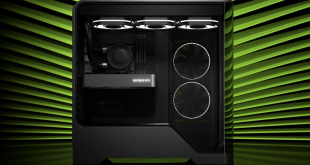
After reviewing Nvidia's RTX 3070 Founders Edition and MSI's RTX 3070 Gaming X Trio last week, today our attention turns to another custom model. The Gigabyte RTX 3070 Gaming OC sports a triple-fan cooler, dual-BIOS functionality and a power limit of 270W, which is an increase of 50W compared to the Founders Edition. But how much of a difference does that make to cooling, noise levels and overall gaming performance? We find out today.
With an MSRP of £539.99 here in the UK, the Gigabyte RTX 3070 Gaming OC is (meant to be!) identically priced to the MSI RTX 3070 Gaming X Trio, which could make a head-to-head comparison between the two very interesting indeed. Gigabyte's GPU may have a fractionally lower rated boost clock of 1815MHz, but its power limit of 270W is what will raise eyebrows – that is a 23% increased over reference, and is still 30W above even a custom card like the MSI Gaming X Trio.
Compared to both RTX 3070s we have reviewed so far, today we put the Gaming OC through its paces, testing it over 11 games while also analysing the thermal performance, noise levels and power draw of the graphics card.
| GPU | RTX 3090 | RTX 3080 | RTX 3070 | RTX 2080 Ti (FE) | RTX 2080 SUPER |
| SMs | 82 | 68 | 46 | 68 | 48 |
| CUDA Cores | 10496 | 8704 | 5888 | 4352 | 3072 |
| Tensor Cores | 328 | 272 | 184 | 544 | 384 |
| RT Cores | 82 | 68 | 46 | 68 | 48 |
| Texture Units | 328 | 272 | 184 | 272 | 192 |
| ROPs | 112 | 96 | 96 | 88 | 64 |
| GPU Boost Clock | 1695 MHz | 1710 MHz | 1725 MHz | 1635 MHz | 1815 MHz |
| Memory Data Rate | 19.5 Gbps | 19 Gbps | 14 Gbps | 14 Gbps | 15.5 Gbps |
| Total Video Memory | 24GB GDDR6X | 10GB GDDR6X | 8GB GDDR6 | 11GB GDDR6 | 8GB GDDR6 |
| Memory Interface | 384-bit | 320-bit | 256-bit | 352-bit | 256-bit |
| Memory Bandwidth | 936 GB/Sec | 760 GB/Sec | 448 GB/Sec | 616 GB/sec | 496.1 GB/sec |
| TGP | 350W | 320W | 220W | 260W | 250W |
To recap its core spec, unlike its more expensive RTX 30-series brethren, the RTX 3070 uses Nvidia’s GA104 GPU, instead of GA102. This implementation of GA104 incorporates 46 Streaming Multiprocessors (SMs), and thanks to Ampere’s new SM structure with its two FP32 datapaths, each SM houses 128 CUDA cores, giving RTX 3070 a total of 5888.
Ampere also places one RT core, and four Tensor cores, in each SM, giving a total of 46 RT cores and 184 Tensor cores. This is accompanied by 184 texture units, and 96 ROPs which are now housed directly within each graphics processing cluster (GPC), with 16 ROPs per GPC, and 6 GPCs in total for RTX 3070.
Clock speed is slightly higher than the RTX 3080. Where the RTX 3070 Founders Edition has a reference clock of 1725MHz, MSI has pushed this to 1830MHz boost. The power limit has also increased from 220W up to 240W.
Lastly, for the memory, RTX 3070 has ditched GDDR6X and we are back to 8GB of 14Gbps GDDR6 memory, operating over a 256-bit bus, for total memory bandwidth of 448 GB/Sec.
 KitGuru KitGuru.net – Tech News | Hardware News | Hardware Reviews | IOS | Mobile | Gaming | Graphics Cards
KitGuru KitGuru.net – Tech News | Hardware News | Hardware Reviews | IOS | Mobile | Gaming | Graphics Cards




